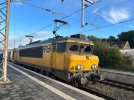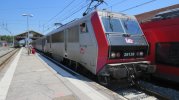citycat
Member
A friend is currently on the Berlin to Amsterdam IC. He wants to know why they use two pantographs on the NS when the lead pantograph is more likely to entangle on the wires?
As the loco was hooking up to the consist at Bad Bentheim when he took the photo, maybe it was for low speed operation?
As the loco was hooking up to the consist at Bad Bentheim when he took the photo, maybe it was for low speed operation?


